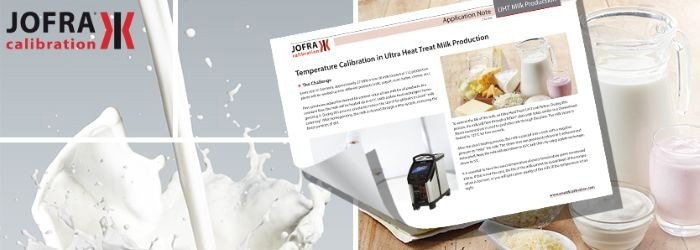Every year, roughly 27 billion tons of milk are processed into various products (such as yogurt, curd, butter, cheese) at 112 manufacturing units across Germany.

Image Credit: AMETEK - JOFRA Calibration
First, producers adjust the required fat content of raw milk for all products. The milk is then heated to 65?°C in a steady flow using a plate heat exchanger, which homogenizes it.
During this process, manufacturers reduce the size of fat globules to prevent "milk creaming." After homogenization, the milk is passed through a filtration system to remove the finest dirt particles.
To extend the shelf life of the milk, an Ultra Heat Treatment (UHT) is applied. In this step, the milk passes through a Teflon® plate with holes, similar to a showerhead. Steam overpressure forces the milk through the plate, heating the milk steam to 125?°C for two seconds.
After this short heating phase, the milk is placed in a tank under negative pressure to "relax" it. The previously injected steam is then released and vented. The milk is cooled to 65?°C and then further reduced to 5?°C using a plate exchanger.
It is critical to maintain accurate temperatures at each of these stages. If the temperature is too low, the milk's shelf life cannot be ensured; if too high, the quality of the milk will decline.
The Solution
UHT system manufacturers often use tri-clamp temperature sensors. The JOFRA RTC-156B dry-block temperature calibrator, which is equipped with an external cable reference sensor and a hygienic and short sensor application insert kit, is an ideal solution for calibrating these sensors.
JOFRA's RTC-156B dry-block calibrator eliminates the need for slow, cumbersome liquid bath calibrations. Instead, it offers a complete, highly accurate, faster, and portable calibration solution.
The standard setup for UHT systems includes a small reference sensor placed alongside the sanitary or short sensor in the dry-block, utilizing dual-zone technology.
AMETEK's engineers have developed a sanitary kit for the RTC-156B dry-block calibrator, along with customized inserts and a short reference sensor specifically for UHT milk applications.

This information has been sourced, reviewed and adapted from materials provided by AMETEK - JOFRA Calibration.
For more information on this source, please visit AMETEK - JOFRA Calibration